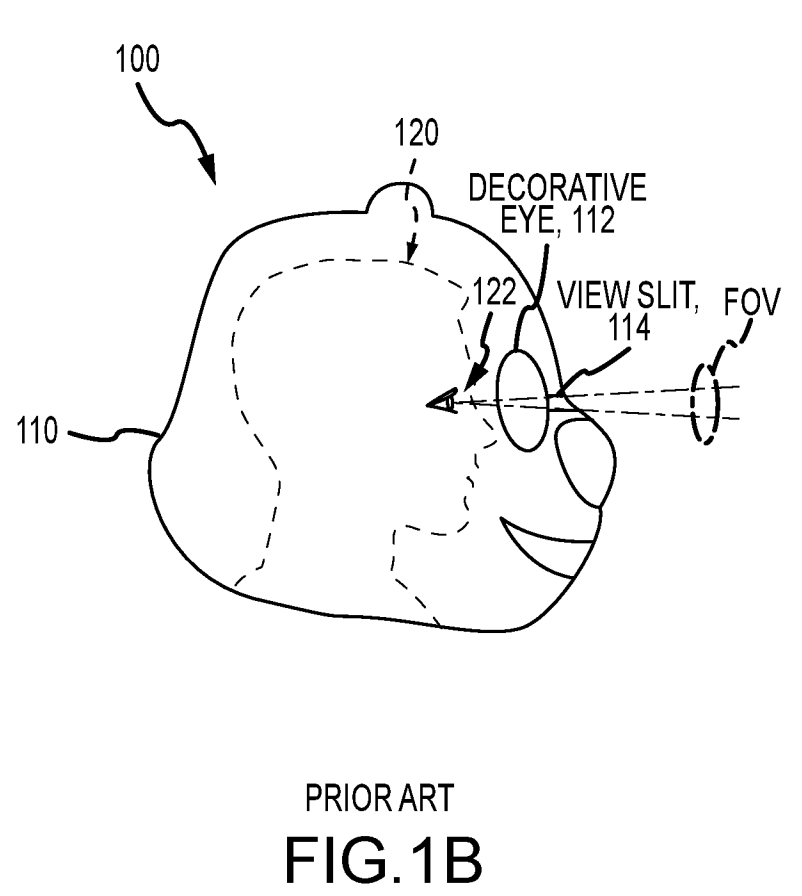Seeing Disney characters in the theme parks and on cruise ships brings joy to fans of all ages. The costumed performers do a great job interacting with guests. However, the costumed performers deal with a safety issue: poor visibility. Disney is experimenting with a solution to solve the visibility problem. A patent application filed with the United States Patent and Trademark Office shows how periscope optics could be used.
Patent application US 2021/0096350 A1 “Optical Viewfinder for Costume Heads” details multiple variations of optics designed to increase the performer’s field of view.
Fig. 1B shows how current costume heads work. A performer’s (120) eyes (122) align with a view slit (114) that is hidden within a decorative eye. The patent application identifies a major issue with this solution. The performer’s eyes do not properly align with the character’s eyes, making the performer’s field of vision very narrow. It also makes it difficult for the performer to interact with guests; it is hard to locate the guest through the narrow view slits.
One additional problem with the traditional costume head concerns character proportions.
Costumed characters in the physical real world need to be the appropriate height and proportions relative to their animated or movie counterparts in their story world.
Patent Application US 2021/0096350 A1
A prior solution for both field of view and proportion issues placed a camera in the walk around costume head. Rather than narrow slits, costume heads like this use a camera (242) aligned with a view slit (214). The camera image is fed to a display (244) that is aligned with the performer’s eyes (122). This eliminates some character proportion issues. The performer’s head is able be positioned lower in the costume.
Of course, video cameras require power. Technology can be glitchy. This patent application offers an “old fashioned” solution. It uses lenses to increase the performer’s field of view. Fig. 3 is similar to Fig. 1B, with the addition of lenses (352, 354). Two lenses are used to prevent the increased field of view from being inverted.
The system detailed in Fig. 3 reintroduces the height and proportion issues that this patent looks to address. In Fig. 4, periscope optics are used to allow the performer’s head to be positioned lower in the costume head. This optic system introduces mirrors (464, 468) and lenses (462, 466, 469) to present a wider field of view to the performer.
Figs. 5, 6, and 7 show how other optic systems could be used. The inventors clearly chose traditional optics — rather than electronics — for reliability and performer safety.
Without electronics, the all-optical viewfinder is robust and future proof. The designed system also has no total optical power so there is no magnification, with a 1:1 image, allowing proper judgment of size and distance (except for the vertical offset from the periscope). The costumed performer can naturally see 3D to judge distances allowing them to comfortably and confidently walk around in and interact with the real world environment. Lack of magnification and the viewing of the scene on a diffusing screen also prevent light sources from being concentrated into the eye.
Patent Application US 2021/0096350 A1
Although direct guest and character interaction is limited during the COVID-19 pandemic, Imagineering is exploring ways to improve interactions when they return.
If implemented, how will the optical viewfinder for costume heads change character – guest interactions? Use the comments to tell us what you think.
If you are interested in other Disney patent applications, be sure to check out these recent posts:
- Disney Patent Application Shows Rotating 2D Displays Capable of Creating Multi-Perspective Interactive 3D Models
- Disney Augmented Reality Patent Application Turns Human Skin Into Communication Network
- Disney Patent Would Bring Video Game Interactivity to Streaming Services Like Disney+
- Disney Files Patent for New Multimedia Show System
- Disney Files Patent for “Smart” Merchandise Displays








